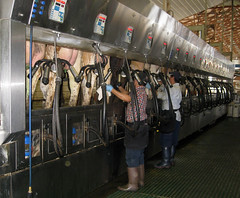US dairy production with historical production practices as exemplified by the US dairy system in 1944.
 A model based on the metabolism and nutrient requirements of the dairy herd was used to estimate resource inputs and waste outputs per billion kg of milk. Both the modern and historical production systems were modeled using characteristic management practices, herd population dynamics, and production data from US dairy farms.
A model based on the metabolism and nutrient requirements of the dairy herd was used to estimate resource inputs and waste outputs per billion kg of milk. Both the modern and historical production systems were modeled using characteristic management practices, herd population dynamics, and production data from US dairy farms.Modern dairy practices require considerably fewer resources than dairying in 1944 with 21% of animals, 23% of feedstuffs, 35% of the water, and only 10% of the land required to produce the same 1 billion kg of milk. Waste outputs were similarly reduced, with modern dairy systems producing 24% of the manure, 43% of CH4, and 56% of N2O per billion kg of milk compared with equivalent milk from historical dairying.
The carbon footprint per billion kilograms of milk produced in 2007 was 37% of equivalent milk production in 1944.
Read full article in the Journal of Animal Science
